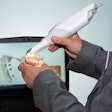A removable splint created using a 3D-printed dental model may provide similar treatment results as a traditional wire-composite splint in children. This study was recently published in the Journal of Dentistry.
Additionally, this approach may reduce the risk of injuries often caused by traditional methods, which can displace or damage traumatized teeth, the authors wrote.
"The removable splints produced using a new 3D-printed dental model can meet clinical treatment requirements of traumatized teeth, especially for children and adolescents with occlusal trauma in mixed dentition," wrote the authors, led by Xiao-Tong Wang of the Peking University School and Hospital of Stomatology in China (J Dent, December 2024, Vol. 151, 105404).
Traumatic dental injuries cause pain, psychological discomfort, and occlusal trauma, especially in children with temporary malocclusion. Removable splints may offer an effective alternative to traditional splinting by eliminating early contact, maintaining tooth position, and supporting periodontal and pulp healing, they wrote.
The study recruited 28 pediatric patients with dental trauma treated at the Peking University Oral Emergency Department between February 2019 and August 2020. Patients were divided into two groups: an experimental group, which received a removable splint made with a 3D-printed dental model using CAD/CAM technology, and a control group that received a wire-composite splint.
Follow-ups were conducted at two weeks, then at one, two, three, six, 12, 18, 24 months, and annually. Evaluations included clinical symptoms, tooth color, mobility, position, percussion pain, abnormal sounds, gum swelling or fistula, vitality tests, and radiographic analysis, they wrote.
The experimental group included 23 traumatized teeth, while the control group had 24. In both groups, over 90% of the traumatized teeth involved open apex cases. Both groups experienced subluxation, extrusive luxation, and lateral luxation, with no significant differences in the proportion of injury types.
The average follow-up time was 35.47 ± 14.23 months for the experimental group and 32.92 ± 14.79 months for the control group (p > 0.05). The experimental group showed higher pulp survival (86.96%) and periodontal healing rates (91.30%) compared to the control group (62.50% and 75.00%, respectively), though the differences were not statistically significant (p > 0.05), they wrote.
However, the study had limitations. Removable splints may be less common due to their complex production and costly materials, the authors added.
"A 3D-printed dental model designed with CAD/CAM technology can be used to fabricate removable splints, which in turn can decrease iatrogenic injuries frequently encountered during the traditional model production process," Wang and colleagues concluded.




















